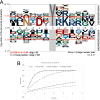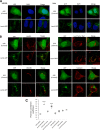Legionella pneumophila effector Lem4 is a membrane-associated protein tyrosine phosphatase
- PMID: 29976756
- PMCID: PMC6109923
- DOI: 10.1074/jbc.RA118.003845
Legionella pneumophila effector Lem4 is a membrane-associated protein tyrosine phosphatase
Abstract
Legionella pneumophila is a Gram-negative pathogenic bacterium that causes severe pneumonia in humans. It establishes a replicative niche called Legionella-containing vacuole (LCV) that allows bacteria to survive and replicate inside pulmonary macrophages. To hijack host cell defense systems, L. pneumophila injects over 300 effector proteins into the host cell cytosol. The Lem4 effector (lpg1101) consists of two domains: an N-terminal haloacid dehalogenase (HAD) domain with unknown function and a C-terminal phosphatidylinositol 4-phosphate-binding domain that anchors Lem4 to the membrane of early LCVs. Herein, we demonstrate that the HAD domain (Lem4-N) is structurally similar to mouse MDP-1 phosphatase and displays phosphotyrosine phosphatase activity. Substrate specificity of Lem4 was probed using a tyrosine phosphatase substrate set, which contained a selection of 360 phosphopeptides derived from human phosphorylation sites. This assay allowed us to identify a consensus pTyr-containing motif. Based on the localization of Lem4 to lysosomes and to some extent to plasma membrane when expressed in human cells, we hypothesize that this protein is involved in protein-protein interactions with an LCV or plasma membrane-associated tyrosine-phosphorylated host target.
Keywords: binding domain; pathogenesis; phosphatase; phosphatidylinositol; structural biology; substrate specificity.
© 2018 Beyrakhova et al.
Conflict of interest statement
The authors declare that they have no conflicts of interest with the contents of this article
Figures








References
Publication types
MeSH terms
Substances
Associated data
- Actions
- Actions
- Actions
- Actions
Grants and funding
LinkOut - more resources
Full Text Sources
Other Literature Sources
Molecular Biology Databases
Research Materials
Miscellaneous

